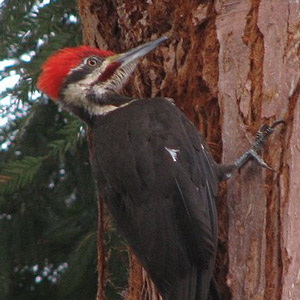Pratique | Débuter
Pourquoi les pics n’ont-ils pas mal à la tête ?

Le Grand Pic (Dryocopus pileatus) peut frapper un tronc à la vitesse de 20 coups à la seconde : mais comment son cerveau résiste-t-il ?Photographie : David Margrave / Wikipedia
Introduction
Comment un pic peut-il supporter les tambourinages qu’il effectue sur les troncs des arbres pour y déloger les insectes, pour délimiter son territoire au printemps ou creuser une cavité pour nidifier ?
Par exemple, le Grand Pic (Dryocopus pileatus) frappe un tronc à la vitesse de 20 coups à la seconde et jusqu’à 12 000 fois par jour, avec une force pouvant atteindre 1,2 kg à chaque impact, largement de quoi s’abîmer le cerveau et décoller la rétine !
Ophtalmologiste renommé diplômé de l’Université de Davis en Californie, Ivan Schwab et son collègue défunt Phillip May (UCLA) ont reçu en octobre 2006 le premier prix lg Nobel d’ornithologie pour avoir compris comment cette famille d’oiseaux s’était adaptée à leur mode de vie de « marteau-piqueur ».
Abstract
The drumming of Woodpeckers is familly specific and may be used for communication or territorial display, but is not related to feeding.
As a result of these activities, Dryocopus pileatus may strike the hard woody surface of a tree at a rate of up to 20 times a second (not a misprint) and up to 12 000 times a day with staggering deceleration forces of as high as 1200 g with each impact. That is equivalent to striking a wall at 16 miles an hour-face first-each time.
When your daily routine involves slamming your head against a tree as it is the case for Woodpeckers, you might expect to get an occasional headache. However, they experience no ill effects from their head-banging ways and, for explaining why, UC Davis ophthalmology professor Ivan Schwab was chosen for the 2006 Ig Nobel Prize in ornithology. He received the award at Harvard University. He shared the prize with the late psychiatrist Phillip R.A. May, whose previous research formed the basis for the study written by Schwab.
Schwab has a special interest in comparative ophthalmology, a field in which he and others examine how insects, birds, reptiles and other nonhuman animals process images.
In his research, May found that woodpeckers have evolved several unique mechanisms that prevent them from inflicting harm upon themselves. Among them are a thick, bony skull with relatively spongy bone, and cartilage at the base of the mandible (lower jaw bone) that partially cushions the incessant blows. The mandibles are attached to the skull by powerful muscles that contract a millisecond before each strike, creating a tight but cushioned structure at the moment of impact and distributing the force of the blow to the base and posterior regions of the skull, thus bypassing the brain.
Poursuivez la lecture de cet article, en vous abonnant dès maintenant !
Découvrez les Archives d’Ornithomedia.com
Pour seulement 10,00 €TTC/an (ou 6,00 € les 6 mois)
Profitez de plusieurs centaines d’articles en accès illimité et sans aucun engagement.
Compléments
Contact
Ivan Schwab
E-mail : irschwab@ucdavis.edu
Ouvrage recommandé
The Minds of Birds de Alexander F. Skutch, Dana Gardner




Aucun commentaire sur ce sujet
Participer à la discussion !